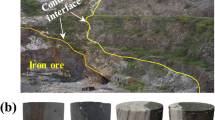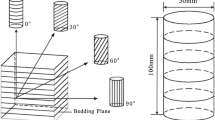Abstract
In this paper, uniaxial compression tests were carried out on a series of composite rock specimens with different dip angles, which were made from two types of rock-like material with different strength. The acoustic emission technique was used to monitor the acoustic signal characteristics of composite rock specimens during the entire loading process. At the same time, an optical non-contact 3D digital image correlation technique was used to study the evolution of axial strain field and the maximal strain field before and after the peak strength at different stress levels during the loading process. The effect of bedding plane inclination on the deformation and strength during uniaxial loading was analyzed. The methods of solving the elastic constants of hard and weak rock were described. The damage evolution process, deformation and failure mechanism, and failure mode during uniaxial loading were fully determined. The experimental results show that the \(\theta = 0{^{\circ }}\)–\(45{^{\circ }}\) specimens had obvious plastic deformation during loading, and the brittleness of the \(\theta = 60{^{\circ }}\)–\(90{^{\circ }}\) specimens gradually increased during the loading process. When the anisotropic angle \(\theta \) increased from \(0{^{\circ }}\) to \(90{^{\circ }}\), the peak strength, peak strain, and apparent elastic modulus all decreased initially and then increased. The failure mode of the composite rock specimen during uniaxial loading can be divided into three categories: tensile fracture across the discontinuities (\(\theta = 0{^{\circ }}\)–\(30{^{\circ }})\), sliding failure along the discontinuities (\(\theta = 45{^{\circ }}\)–\(75{^{\circ }})\), and tensile-split along the discontinuities (\(\theta = 90{^{\circ }})\). The axial strain of the weak and hard rock layers in the composite rock specimen during the loading process was significantly different from that of the \(\theta = 0{^{\circ }}\)–\(45{^{\circ }}\) specimens and was almost the same as that of the \(\theta = 60{^{\circ }}\)–\(90{^{\circ }}\) specimens. As for the strain localization highlighted in the maximum principal strain field, the \(\theta = 0{^{\circ }}\)–\(30{^{\circ }}\) specimens appeared in the rock matrix approximately parallel to the loading direction, while in the \(\theta = 45{^{\circ }}\)–\(90{^{\circ }}\) specimens it appeared at the hard and weak rock layer interface.






























Similar content being viewed by others
Change history
25 November 2017
In the original publication of this article, Table 2 is incorrectly published due to the negligence of the author’s proofreading. The correct version of Table 2 is provided below.
25 November 2017
In the original publication of this article, Table��2 is incorrectly published due to the negligence of the author���s proofreading. The correct version of Table��2 is provided below.
25 November 2017
In the original publication of this article, Table��2 is incorrectly published due to the negligence of the author���s proofreading. The correct version of Table��2 is provided below.
References
Barla, G.: Full-face excavation of large tunnels in difficult conditions. J. Rock Mech. Geotech. Eng. 8, 294–303 (2016)
Tien, Y.M., Kuo, M.C., Juang, C.H.: An experimental investigation of the failure mechanism of simulated transversely isotropic rocks. Int. J. Rock Mech. Min. Sci. 43, 1163–1181 (2006)
Zhang, J.C.: Borehole stability analysis accounting for anisotropies in drilling to weak bedding planes. Int. J. Rock Mech. Min. Sci. 60, 160–170 (2013)
Stille, H., Palmström, A.: Ground behaviour and rock mass composition in underground excavations. Tunn. Undergr. Space Technol. 23, 46–64 (2008)
Babendererde, S., Hoek, E., Marinos, P., et al.: Characterization of granite and the underground construction in metro do Porto, Portugal. In: International Conference on Site Characterization, Portugal, September 19–22 (2004)
Nasseri, M.H.B., Rao, K.S., Ramamurthy, T.: Anisotropic strength and deformational behavior of Himalayan schists. Int. J. Rock Mech. Min. Sci. 40, 3–23 (2003)
Colak, K., Unlu, T.: Effect of transverse anisotropy on the Hoek–Brown strength parameter ‘ \(\text{m}_{{\rm i}}\) ’ for intact rocks. Int. J. Rock Mech. Min. Sci. 41, 1045–1052 (2004)
Adhikary, D.P., Guo, H.: An orthotropic cosserat elasto-plastic model for layered rocks. Rock Mech. Rock Eng. 35, 161–170 (2002)
Tien, Y.M., Kuo, M.C.: A failure criterion for transversely isotropic rocks. Int. J. Rock Mech. Min. Sci. 38, 399–412 (2001)
Chu, T.C., Ranson, W.F., Sutton, M.A.: Applications of digital image correlation techniques to experimental mechanics. Exp. Mech. 25, 232–244 (1985)
Bay, B.K., Smith, T.S., Fyhrie, D.P., et al.: Digital volume correlation: three-dimensional strain mapping using X-ray tomography. Exp. Mech. 39, 217–226 (1999)
Pan, B., Xie, H., Yang, L., et al.: Accurate measurement of satellite antenna surface using 3D digital Image correlation technique. Strain 45, 194–200 (2009)
Sutton, M.A., Orteu, J.J., Schreier, H.: Image Correlation for Shape, Motion and Deformation Measurements. Springer, US (2009)
Caduff, D., Mier, J.G.M.V.: Analysis of compressive fracture of three different concretes by means of 3D-digital image correlation and vacuum impregnation. Cem. Concr. Compos. 32, 281–290 (2010)
Helfrick, M.N., Niezrecki, C., Avitabile, P., et al.: 3D digital image correlation methods for full-field vibration measurement. Mech. Syst. Signal Process. 25, 917–927 (2011)
Tang, Z., Liang, J., Xiao, Z., et al.: Large deformation measurement scheme for 3D digital image correlation method. Opt. Lasers Eng. 50, 122–130 (2012)
Malesa, M., Malowany, K., Tomczak, U., et al.: Application of 3D digital image correlation in maintenance and process control in industry. Comput. Ind. 64, 1301–1315 (2013)
Munoz, H., Taheri, A., Chanda, E.K.: Pre-peak and post-peak rock strain characteristics during uniaxial compression by 3D digital image correlation. Rock Mech. Rock Eng. 49, 2541–2554 (2016)
Louis, L., Wong, T.F., Baud, P.: Imaging strain localization by X-ray radiography and digital image correlation: deformation bands in Rothbach sandstone. J. Struct. Geol. 29, 129–140 (2007)
Tudisco, E., Hall, S.A., Charalampidou, E.M., et al.: Full-field measurements of strain localisation in sandstone by neutron tomography and 3D-volumetric digital image correlation. Phys. Procedia 69, 509–515 (2015)
Nunes, A.L.L.S.: A new method for determination of transverse isotropic orientation and the associated elastic parameters for intact rock. Int. J. Rock Mech. Min. Sci. 39, 257–273 (2002)
Gonzaga, G.G., Leite, M.H., Corthésy, R.: Determination of anisotropic deformability parameters from a single standard rock specimen. Int. J. Rock Mech. Min. Sci. 45, 1420–1438 (2008)
Amadei, B.: Importance of anisotropy when estimating and measuring in situ stresses in rock. Int. J. Rock Mech. Min. Sci. Geomech. Abstr. 33, 293–325 (1996)
Hakala, M., Kuula, H., Hudson, J.A.: Estimating the transversely isotropic elastic intact rock properties for in situ stress measurement data reduction: a case study of the Olkiluoto mica gneiss, Finland. Int. J. Rock Mech. Min. Sci. 44, 14–46 (2007)
Cho, J.W., Kim, H., Jeon, S., et al.: Deformation and strength anisotropy of Asan gneiss, Boryeong shale, and Yeoncheon schist. Int. J. Rock Mech. Min. Sci. 50, 158–169 (2012)
Saint-Venant, B.: Sur la distribution des elastici & autour de chaque point d’un sohde ou dun milieu de contexture quelconque. J. Math. Pures Appl. 7–8, 353–430 (1863). (in French)
Acknowledgements
The project was supported by the National Basic Research 973 Program of China (Grant 2014CB046905), the Natural Science Foundation of Jiangsu Province for Distinguished Young Scholars (Grant BK20150005), the Fundamental Research Funds for the Central Universities (China University of Mining and Technology) (Grant 2014XT03), and the innovation research project for academic graduate of Jiangsu Province (Grant KYLX16_0536). We would also like to acknowledge the editor and the anonymous reviewers for their valuable comments, which have greatly improved this paper.
Author information
Authors and Affiliations
Corresponding author
Rights and permissions
About this article
Cite this article
Cheng, JL., Yang, SQ., Chen, K. et al. Uniaxial experimental study of the acoustic emission and deformation behavior of composite rock based on 3D digital image correlation (DIC). Acta Mech. Sin. 33, 999–1021 (2017). https://doi.org/10.1007/s10409-017-0706-3
Received:
Revised:
Accepted:
Published:
Issue Date:
DOI: https://doi.org/10.1007/s10409-017-0706-3




